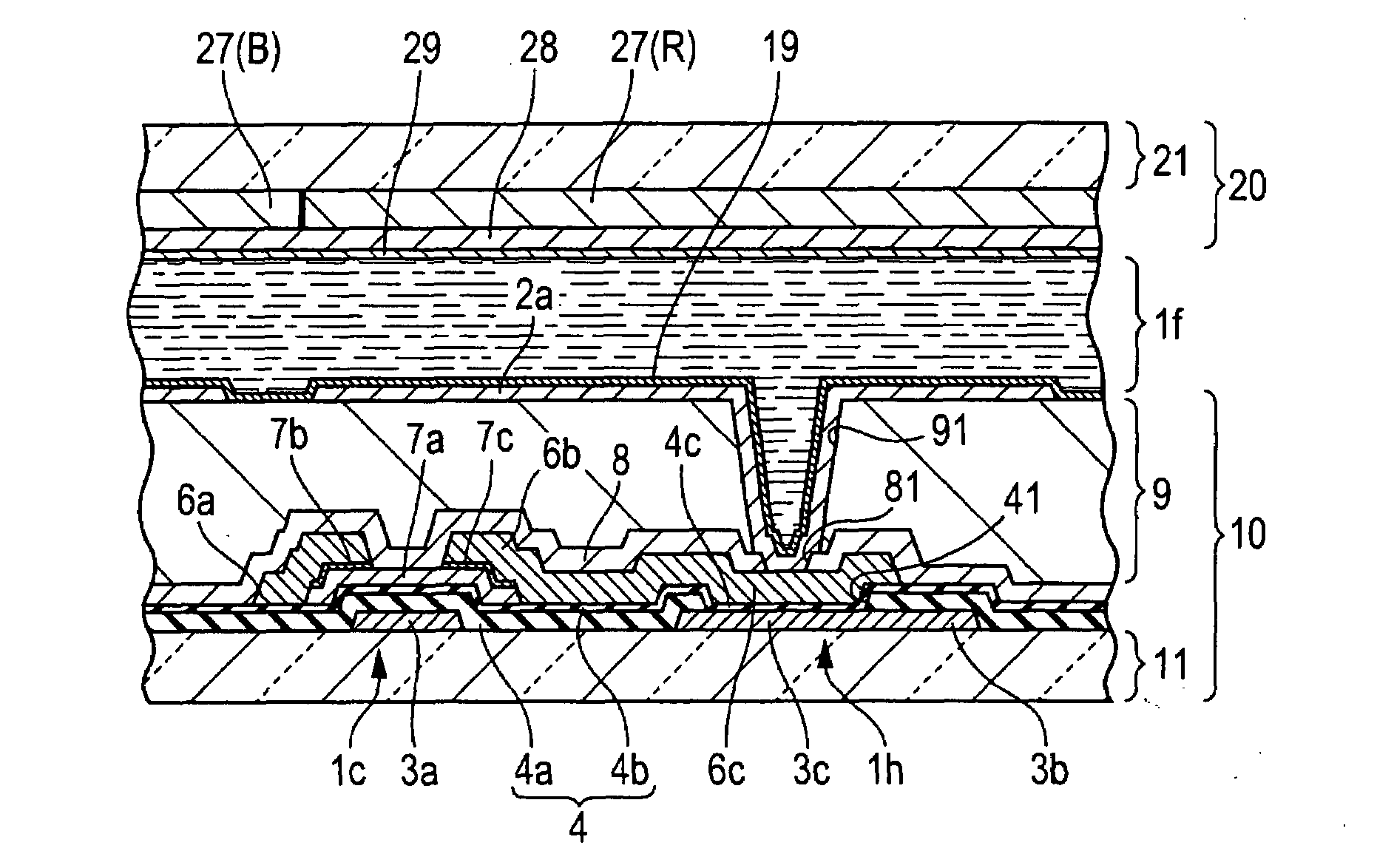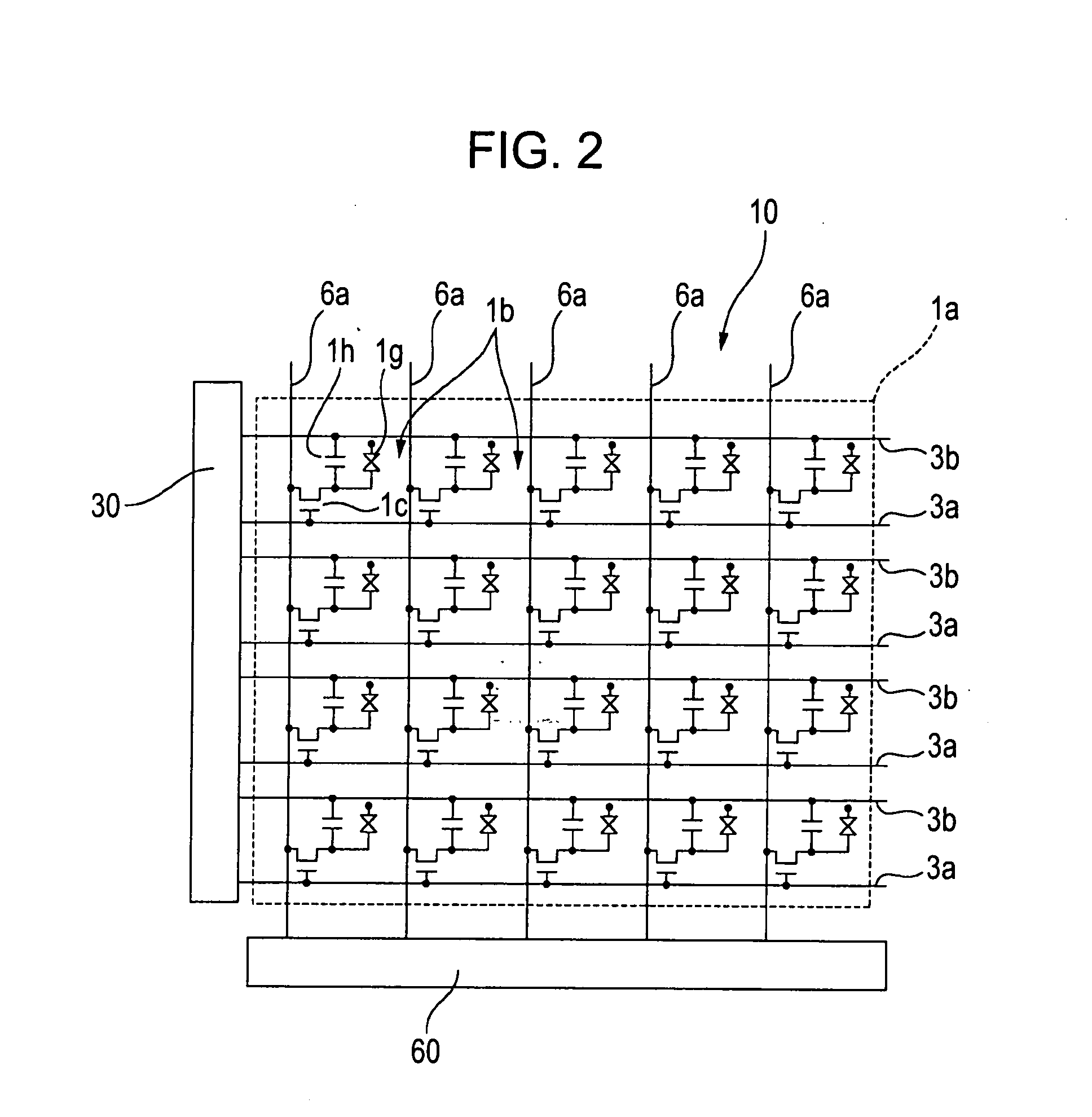Electro-optical device and electronic apparatus
a technology of optical devices and electronic devices, applied in electrical devices, semiconductor devices, instruments, etc., can solve the problems of reduced dielectric strength or dielectric breakdown, inability to uniformly generate electric fields across, and reduced dielectric strength, so as to reduce thickness and reduce dielectric strength
- Summary
- Abstract
- Description
- Claims
- Application Information
AI Technical Summary
Benefits of technology
Problems solved by technology
Method used
Image
Examples
first embodiment
[0039]An electro-optical device 1 according to a first embodiment of the present invention will now be described. FIG. 1A shows the electro-optical device 1 in plan view and FIG. 1B shows the electro-optical device 1 in sectional view taken along the line IB-IB of FIG. 1A. The electro-optical device 1 is a transmissive active matrix liquid crystal device operating in a twisted nematic (TN) mode, an electrically controlled birefringence (ECB) mode, or a vertical aligned nematic (VAN) mode. The electro-optical device 1 includes an element substrate 10 and a counter substrate 20 that is bonded to the element substrate 10 with a sealing member 22 disposed therebetween. A liquid crystal 1f is held between the element and counter substrates 10 and 20. The element substrate 10 has an end region located outside of the sealing member 22. A data line-driving integrated circuit (IC) 60 and a scanning line-driving IC 30 are mounted on the end region of the element substrate 10 by a chip-on-glas...
second embodiment
[0079]FIG. 8A shows one of pixels 1b disposed in an electro-optical device 1 according to a second embodiment of the present invention in plan view and FIG. 8B shows the pixel 1b in sectional view taken along the line VIIIB-VIIIB of FIG. 8A. FIG. 9A shows one of storage capacitors 1h disposed in the electro-optical device 1 shown in FIG. 8 in plan view in an enlarged manner, FIG. 9B shows one of regions overlapping with end portions of lower electrodes 3c and upper electrodes 6c in sectional view in an enlarged manner, and FIG. 9C shows one of regions overlapping with the lower electrodes 3c and end portions of the upper electrodes 6c in sectional view in an enlarged manner. With reference to FIG. 8A, pixel electrodes 2a are shown by thick broken lines, gate lines 3a and thin-films formed together therewith are shown by thin solid lines, source lines 6a and thin-films formed together therewith are shown by thin dotted-chain lines, and semiconductor layers 7a are shown by thin dotted...
third embodiment
[0088]FIG. 11A shows one of pixels 1b disposed in an electro-optical device 1 according to a third embodiment of the present invention in plan view and FIG. 11B shows the pixel 1b in sectional view taken along the line XIB-XIB of FIG. 11A. With reference to FIG. 11A, pixel electrodes 2a are shown by thick broken lines, gate lines 3a and thin-films formed together therewith are shown by thin solid lines, source lines 6a and thin-films formed together therewith are shown by thin dotted-chain lines, and semiconductor layers 7a are shown by thin dotted lines. Furthermore, dielectric layers 4c of storage capacitors 1h that are thin portions of a gate insulating layer 4 are shown by thick solid lines and contact holes as well as the gate lines 3a are shown by thin solid lines. The electro-optical device 1 of this embodiment has substantially the same configuration as that of the electro-optical device 1 of the first embodiment; hence, components common to these devices have the same refer...
PUM
 Login to View More
Login to View More Abstract
Description
Claims
Application Information
 Login to View More
Login to View More - R&D
- Intellectual Property
- Life Sciences
- Materials
- Tech Scout
- Unparalleled Data Quality
- Higher Quality Content
- 60% Fewer Hallucinations
Browse by: Latest US Patents, China's latest patents, Technical Efficacy Thesaurus, Application Domain, Technology Topic, Popular Technical Reports.
© 2025 PatSnap. All rights reserved.Legal|Privacy policy|Modern Slavery Act Transparency Statement|Sitemap|About US| Contact US: help@patsnap.com



